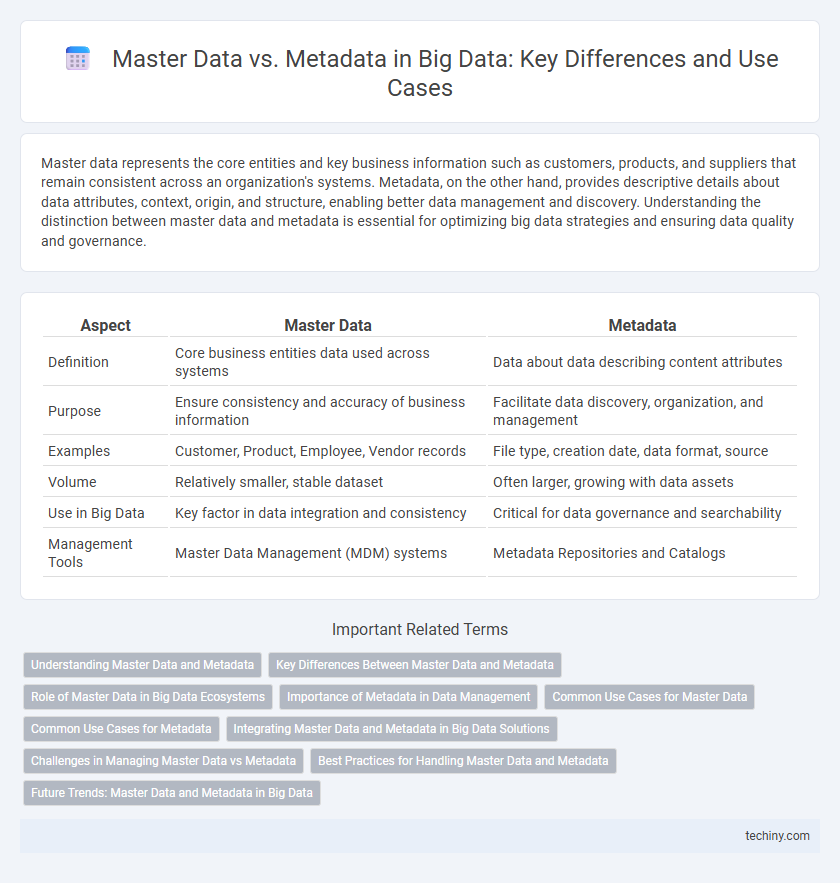Master data represents the core entities and key business information such as customers, products, and suppliers that remain consistent across an organization's systems. Metadata, on the other hand, provides descriptive details about data attributes, context, origin, and structure, enabling better data management and discovery. Understanding the distinction between master data and metadata is essential for optimizing big data strategies and ensuring data quality and governance.
Table of Comparison
| Aspect | Master Data | Metadata |
|---|---|---|
| Definition | Core business entities data used across systems | Data about data describing content attributes |
| Purpose | Ensure consistency and accuracy of business information | Facilitate data discovery, organization, and management |
| Examples | Customer, Product, Employee, Vendor records | File type, creation date, data format, source |
| Volume | Relatively smaller, stable dataset | Often larger, growing with data assets |
| Use in Big Data | Key factor in data integration and consistency | Critical for data governance and searchability |
| Management Tools | Master Data Management (MDM) systems | Metadata Repositories and Catalogs |
Understanding Master Data and Metadata
Master data represents the core business entities such as customers, products, and locations, serving as the foundation for transactional and analytical processes in Big Data environments. Metadata provides descriptive information about the data itself, including its origin, structure, and context, enabling effective data governance and usability. Comprehending the distinction between master data and metadata is essential for ensuring data quality, consistency, and efficient management in large-scale data systems.
Key Differences Between Master Data and Metadata
Master Data represents the core business entities such as customers, products, and suppliers, providing consistent, non-transactional information essential for operations and analytics. Metadata, on the other hand, describes the structure, context, and characteristics of data assets, including data source details, format, and creation timestamps, enabling effective data management and governance. Key differences lie in their purpose and scope: Master Data maintains primary entities for business processes, whereas Metadata offers descriptive information to interpret, locate, and manage data.
Role of Master Data in Big Data Ecosystems
Master Data serves as the authoritative, consistent reference for critical business entities within Big Data ecosystems, enabling accurate data integration and analytics across diverse sources. It ensures data quality and harmonization, supporting operational efficiency and decision-making by providing a single source of truth for customers, products, and suppliers. Effective Master Data management enhances the value of Big Data investments by reducing redundancy and driving reliable insights.
Importance of Metadata in Data Management
Metadata plays a crucial role in data management by providing essential context and structure that enable effective organization, discovery, and usage of big data assets. Unlike master data, which represents the core business entities, metadata describes the characteristics, origin, and format of data, facilitating data governance, lineage tracking, and quality control. High-quality metadata enhances data integration, accelerates analytics processes, and ensures compliance with regulatory standards within complex big data environments.
Common Use Cases for Master Data
Master data is crucial for maintaining consistent and accurate information across enterprise systems, commonly used in customer relationship management (CRM) to unify client profiles and transaction histories. It supports supply chain management by standardizing product, vendor, and inventory data, enhancing operational efficiency and decision-making accuracy. Master data also underpins financial reporting processes, ensuring reliable aggregation of transactional data for compliance and audit purposes.
Common Use Cases for Metadata
Metadata in big data environments commonly supports data discovery, governance, and quality management by providing context, lineage, and usage details. It enables efficient data cataloging for faster analytics and enhances data security through role-based access controls. Metadata also facilitates compliance with regulatory standards by tracking data provenance and audit trails.
Integrating Master Data and Metadata in Big Data Solutions
Integrating master data and metadata in big data solutions enhances data accuracy and context by linking core business entities with descriptive information that facilitates data discovery and management. Master data consolidation ensures consistent reference points across systems, while metadata provides critical insights into data lineage, quality, and usage patterns, enabling advanced analytics and governance. Efficient integration supports scalable data architectures, improves compliance, and drives actionable intelligence in complex big data environments.
Challenges in Managing Master Data vs Metadata
Master Data management faces challenges such as ensuring data consistency, accuracy, and integration across multiple systems, while Metadata management struggles with capturing detailed context, lineage, and evolving schema definitions. Master Data requires rigorous governance to maintain a single source of truth, whereas Metadata demands scalable storage and dynamic updating to support search, discovery, and compliance. Both domains must address quality control but differ in complexity due to Master Data's direct impact on business processes versus Metadata's role in data understanding and usability.
Best Practices for Handling Master Data and Metadata
Master data should be maintained with strict governance frameworks to ensure accuracy, consistency, and security across all business units, employing standardized naming conventions and regular audits. Metadata requires comprehensive cataloging and precise classification to improve data discoverability and enhance analytics processes within big data environments. Implementing automated tools for data lineage and version control supports efficient master and metadata management, reducing errors and facilitating regulatory compliance.
Future Trends: Master Data and Metadata in Big Data
Emerging trends in big data emphasize the integration of master data and metadata through advanced AI-driven frameworks to enhance data governance and analytics accuracy. Organizations increasingly adopt unified data models that leverage real-time metadata to dynamically update master data, improving decision-making speed and reliability in large-scale environments. Future developments focus on automated metadata generation and semantic enrichment, enabling more intelligent data discovery and interoperability across complex big data ecosystems.
Master Data vs Metadata Infographic

 techiny.com
techiny.com